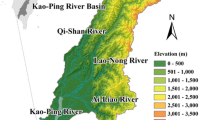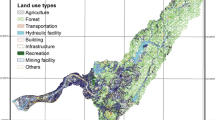Abstract
A mountain disaster chain always brings about potential danger to the safety of people and the environment based on its characteristics of long time-scale, great destructive power, and broad scope. Mechanisms responsible for this hazard are represented by studying a landslide-caused disaster chain that occurred in the bank of Jinshajiang River, China on 10 October 2018. The evolution process of this disaster chain is simulated and analyzed using a coupled model that consists of several depth-averaged equations, and the results agree well with the measured data. Furthermore, several factors, including frictional coefficient, inflow flux, and critical dam slope coefficient, are tested by applying different values. Results indicate that the evolution of a mountain disaster chain can change at each stage with different initial conditions.








Similar content being viewed by others
References
Andersen S, Andersen L (2010) Modelling of landslides with the material-point method. Comput Geosci 14(1):137–147
Allstadt K (2013) Extracting source characteristics and dynamics of the august 2010 mount meager landslide from broadband seismograms. Journal of Geophysical Research: Earth Surface 118(3):1472–1490
Becker JS, Johnston DM, Paton D, Hancox GT, Davies TR, McSaveney MJ, Manville VR (2007) Response to landslide dam failure emergencies: issues resulting from the October 1999 Mount Adams landslide and dam-break flood in the Poerua River, Westland, New Zealand. Natural hazards review 8(2):35–42
Costa J (1988) Floods from dam failure. Floods Geomorphology:436–439
Cao Z, Yue Z, Pender G (2011) Landslide dam failure and flood hydraulics. Part II: coupled mathematical modelling. Nat Hazards 59(2):1021–1045
Chen TC, Lin ML, Wang KL (2014) Landslide seismic signal recognition and mobility for an earthquake-induced rockslide in Tsaoling, Taiwan. Eng Geol 171:31–44
Chen HX, Zhang LM, Gao L, Zhu H, Zhang S (2015) Presenting regional shallow landslide movement on three-dimensional digital terrain. Eng Geol 195:122–134
Dai FC, Lee CF, Deng JH, Tham LG (2005) The 1786 earthquake-triggered landslide dam and subsequent dam-break flood on the Dadu River, southwestern China. Geomorphology 65(3–4):205–221
Fan XM, Zhan W, Dong X, van Westen C, Xu Q, Dai L et al (2018) Analyzing successive landslide dam formation by different triggering mechanisms: the case of the Tangjiawan landslide, Sichuan, China. Eng Geol 243:128–144
Fan X, Xu Q, Alonso-Rodriguez A, Subramanian SS, Li W, Zheng G et al (2019) Successive landsliding and damming of the Jinsha River in eastern Tibet, China: prime investigation, early warning, and emergency response. Landslides 16(5):1003–1020
Hungr O, Evans SG, Hutchinson I (2001) A review of the classification of landslides of the flow type. Environmental & Engineering Geoscience 7(3):221–238
Helmstetter A, Garambois S (2010) Seismic monitoring of Séchilienne rockslide (French Alps): analysis of seismic signals and their correlation with rainfalls. Journal of Geophysical Research: Earth Surface 115(F3)
Iverson, R. M., & George, D. L. (2014). A depth-averaged debris-flow model that includes the effects of evolving dilatancy. I. Physical basis. Proc. r. Soc. a, 470(2170), 20130819
Legros F (2002) The mobility of long-runout landslides. Eng Geol 63(3–4):301–331
Liang D, Falconer RA, Lin B (2006) Comparison between TVD-MacCormack and ADI-type solvers of the shallow water equations. Adv Water Resour 29(12):1833–1845
Lucas A, Mangeney A, Ampuero JP (2014) Frictional velocity-weakening in landslides on Earth and on other planetary bodies. Nat Commun 5:3417
Lobovský L, Botia-Vera E, Castellana F, Mas-Soler J, Souto-Iglesias A (2014) Experimental investigation of dynamic pressure loads during dam break. Journal of Fluids and Structures 48:407–434
Liu W, He S (2016) A two-layer model for simulating landslide dam over mobile river beds. Landslides 13(3):565–576
Liu W, He S (2018) Dynamic simulation of a mountain disaster chain: landslides, barrier lakes, and outburst floods. Nat Hazards 90(2):757–775
McDougall S, Hungr O (2005) Dynamic modelling of entrainment in rapid landslides. Can Geotech J 42(5):1437–1448
Ma G, Kirby JT, Hsu TJ, Shi F (2015) A two-layer granular landslide model for tsunami wave generation: theory and computation. Ocean Model 93:40–55
Rickenmann D, Recking A (2011) Evaluation of flow resistance in gravel-bed rivers through a large field data set. Water Resour Res 47(7)
Shang Y, Yang Z, Li L, Liu DA, Liao Q, Wang Y (2003) A super-large landslide in Tibet in 2000: background, occurrence, disaster, and origin. Geomorphology 54(3):225–243
Xu L, Ou X, Lai Z, Zhou S, Wang J, Fu Y (2010) Timing and style of Late Pleistocene glaciation in the Queer Shan, northern Hengduan Mountains in the eastern Tibetan Plateau. J Quat Sci 25(6):957–966
Yavari-Ramshe S, Ataie-Ashtiani B (2016) Numerical modeling of subaerial and submarine landslide-generated tsunami waves—recent advances and future challenges. Landslides 13(6):1325–1368
Zheng X.F., Ouyang B., Zhang D.N., Yao Z.X., Liang J.H., Zheng J. (2009). ‘Technical system construction of data backup centre for China Seismograph Network and the data support to researches on the Wenchuan earthquake’. Chin J Geophys, 52(5):1412–1417 (in Chinese)
Zheng XF, Yao ZX, Liang JH, Zheng J (2010) The role played and opportunities provided by IGP DMC of China National Seismic Network in Wenchuan earthquake disaster relief and research. Bull Seismol Soc Am 100(5B):286–2872. https://doi.org/10.1785/0120090257
Acknowledgments
Waveform data for this study are provided by the Data Management Centre of the China National Seismic Network at the Institute of Geophysics, China Earthquake Administration. DEM data for this study is provided by the Sichuan Geomatics Center.
Funding
We thank two anonymous reviewers for their constructive comments on this manuscript. This work was supported by the National Natural Science Foundation of China (Grant nos. 41907241, 41790433), Original Innovation Program, CAS (Grant no. ZDBS-LY-DQC039), the Foundation for Young Scientist of Institute of Mountain Hazards and Environment, CAS (Grant No. SDS-QN-1901), and CAS “Light of West China” Program.
Author information
Authors and Affiliations
Corresponding author
Rights and permissions
About this article
Cite this article
Liu, W., Ju, N., Zhang, Z. et al. Simulating the process of the Jinshajiang landslide-caused disaster chain in October 2018. Bull Eng Geol Environ 79, 2189–2199 (2020). https://doi.org/10.1007/s10064-019-01717-6
Received:
Accepted:
Published:
Issue Date:
DOI: https://doi.org/10.1007/s10064-019-01717-6




